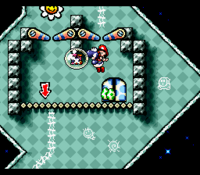Flipper
- This article is about the object from the Mario franchise. For the flipper from Balloon Fight that appears in Super Smash Bros. Melee, see Flipper (Balloon Fight). For the flippers that appear in Mario Kart DS and Mario Kart 7, see Flipper (Mario Kart series).
Flippers[1][2], also known as one-way gates[3], are bars that, once passed through, prevent access to the area before. They are commonly referred to as "pinball flippers" due to their resemblance to flippers from a pinball game. Yoshi can open them temporarily if he jumps on them.
Debuting in Super Mario World 2: Yoshi's Island, the flippers show up again in Super Mario Advance 4: Super Mario Bros. 3 in the following World-e levels: Slidin' the Slopes, Doors o' Plenty, Swinging Bars of Doom, Sea to Sky, Puzzling Pipe Maze and Treacherous Halls. In this game, they are colored yellow.
A similar type of flippers appears in New Super Mario Bros. in World 2-3 only. These types are wooden flippers with red arrows on them indicating which way it opens to, and are usually found individually rather than in pairs. Flippers exist unused in New Super Mario Bros. Wii; however, they reappear in New Super Mario Bros. 2 in a few levels.
They reappear in Yoshi's Woolly World, serving the same function as in previous Yoshi games.
Names in other languages
| Language | Name | Meaning |
|---|---|---|
| Japanese | 一方通行ゲート[4] Ippōtsūkō Gēto |
One-Way Gate |
See also
References
- ^ The Super Mario World 2: Yoshi's Island. Player's Guide, page 122.
- ^ Williams, Drew. The Yoshi's Island DS Player's Guide. Pages 72, 80, 82, 127.
- ^ Black, Fletcher. Yoshi's Island DS PRIMA Official Game Guide. Pages 94, 173, 175, 179, 180, 190, 193, 197, 212, 213, 220, 225, 228, 264, 267, 271, 274.
- ^ Shogakukan. 2015. Super Mario Bros. Hyakka: Nintendo Kōshiki Guidebook, pages 118 and 199.
